Infrastructure
Empowering Governance through Digital Infrastructure
Posted On: 15 AUG 2025 16:13 PM
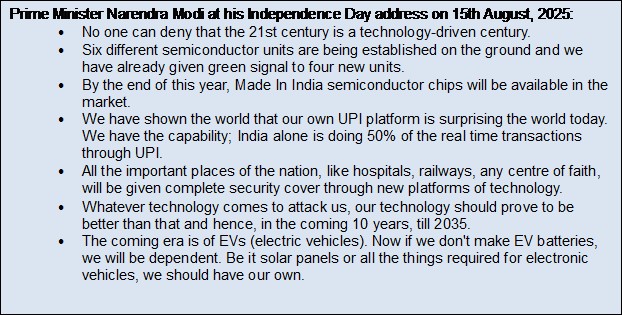
Introduction
Digital India is bridging the gap between citizens and governance, connecting systems with essential services, and transforming challenges into solutions. It is more than a technological initiative; it is a national mission that underpins Aatmanirbhar Bharat, reflecting the strength, capability, and self-reliance of a confident India in the 21st century. By replacing physical paperwork with digital processes, it has enhanced transparency, accessibility, and efficiency in public service delivery.
The digital economy contributed 11.74% to national income in 2022–23 and is projected to rise to 13.42% by 2024–25, driven by advancements in artificial intelligence, cloud computing, and digital infrastructure. India ranks third globally in digitalisation and, by 2030, the digital economy is expected to account for nearly one-fifth of overall GDP. As the nation marks its 79th Independence Day, these achievements underscore India’s progress towards inclusive and technology-driven growth.
Achievements Demonstrating India’s Self-Reliance in the Digital Landscape
Growth in Electronics Manufacturing
Guided by the vision of achieving net zero imports and strengthening domestic capabilities, the Production-Linked Incentive (PLI) Scheme for Large Scale Electronics Manufacturing has driven exceptional growth in India’s electronics sector over the past decade. Through targeted incentives, economies of scale, a focus on specialised electronic products, and talent development, India has emerged as a competitive global hub for electronics production and exports.
- Production of electronics goods increased from ₹1.9 lakh crore in 2014–15 to ₹11.3 lakh crore in 2024–25, marking a 6-fold growth.
- Exports of electronics goods jumped from ₹38,000 crore to ₹3.27 lakh crore, an 8-fold increase.
Mobile Phones – A Major Driver of Growth
Ensuring mobile coverage in remote and underserved areas has been a key focus, enabling all citizens to connect to the digital ecosystem and access essential services.
Key Facts:
- Mobile manufacturing units rose from just 2 in 2014–15 to 300 in 2024–25, 150 times more.
- Mobile phone production surged from ₹18,000 crore in 2014-15 to ₹5.45 lakh crore in 2024-25, a 28-fold growth.
- Mobile phone exports skyrocketed from ₹1,500 crore in 2014-15 to ₹2 lakh crore in 2024-25, increasing 127 times.
- Mobile phone imports dropped drastically from 75% of total demand in 2014-15 to just 0.02% in 2024-25, showing near-complete self-reliance.
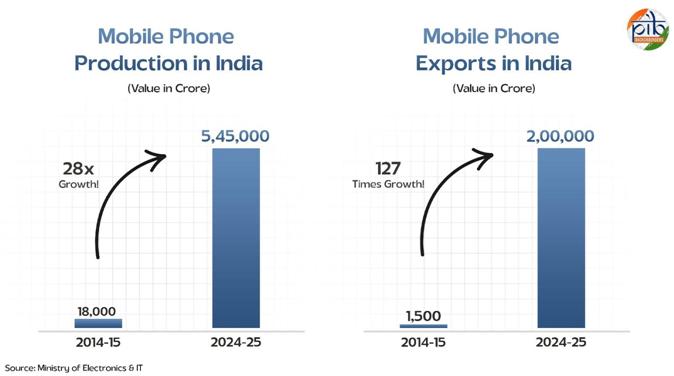
Enhanced Telecommunications Infrastructure
Digital India aims to provide services to citizens electronically through enhanced online infrastructure and improved internet connectivity, with a special focus on linking rural areas to high-speed networks. These efforts have significantly expanded telecommunications and broadband access across the country.
Key Facts:
- Telephone connections increased from 93.3 crore (2014) to 120+ crore (2025).
- Tele-density grew from 75.23% (2014) to 84.49% (2024).
- Urban connections rose from 555 million to 661 million; rural connections increased from 377 million to 527 million.
- Mobile subscribers reached 116 crore (2025).Wireless data cost dropped drastically from ₹308/GB (2014) to ₹9.34/GB (2022), making digital services more affordable.
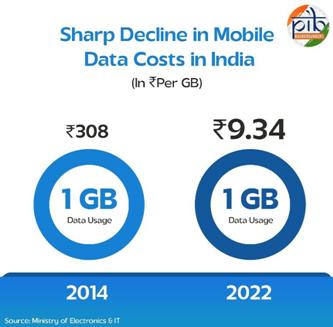
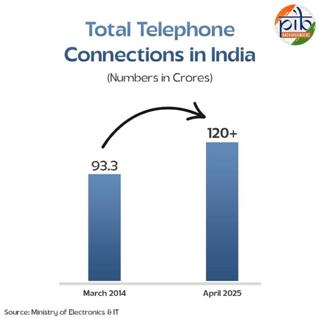
Internet and Digital Connectivity
Efforts under Digital India have focused on high-speed internet access, broadband expansion, and connectivity for rural areas.
Key Facts:
- Internet connections jumped from 25.15 crore (2014) to 96.96 crore (2024), a growth of 286%.
- Broadband connections rose from 6.1 crore in March 2024 to 94.92 crore in August 2024, an increase of 1,452%.
- As of May 2025, out of 6,44,131 villages in the country (as per data of Registrar General of India), 6,29,027 villages i.e. 97.65% villages, are covered with mobile connectivity and out of these, 6,23,512 villages i.e. 96.80% villages, have 4G mobile connectivity.
- Since the 5G launch in Oct 2022, 4.74 lakh 5G towers have been installed, covering 99.6% of districts.
- As of June 2025, 2,14,325 Gram Panchayats (GPs) have been made service-ready under the BharatNet project. So far, 13,01,193 Fibre-to-the-Home (FTTH) connections have been provided under BharatNet, including connections to rural schools.
- Under PM-WANI, 3,33,300 public Wi-Fi hotspots have been installed (June 2025), accelerating internet access for citizens, including farmers.
UPI: Powering Clear and Seamless Transactions
Over the past decade, technology has transformed how India pays, moving the nation away from cash and card-based transactions towards a digital-first economy. At the heart of this shift is UPI, enabling millions of individuals and small businesses in rural and remote areas to make fast, secure and low-cost payments, driving financial inclusion like never before.
Key Takeaways
- IMF notes India as the global leader in fast payments.
- ₹24.03 lakh crore processed via 18.39 billion UPI transactions in June 2025 — a 32% growth from 13.88 billion in June 2024.
- UPI serves 491 million individuals, 65 million merchants, and connects 675 banks on one platform.
- UPI powers 85% of India’s digital payments and nearly 50% of global real-time digital payments.
- Handles 640+ million transactions daily, ahead of Visa’s 639 million.
- Live in 7 countries: UAE, Singapore, Bhutan, Nepal, Sri Lanka, France, and Mauritius — France being its first European entry.
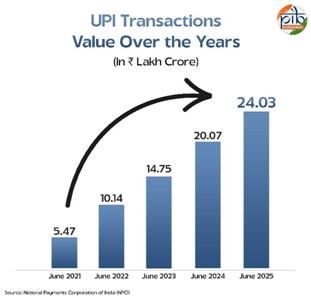
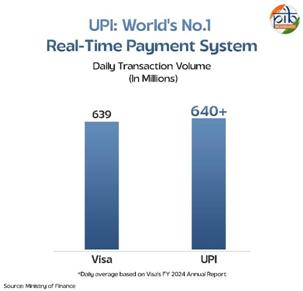
Digital Commerce
ONDC
Launched in 2022, operates in 616+ cities with 7.64 lakh+ sellers/service providers. ONDC enables sellers, including MSMEs, SHGs, artisans, and women-led enterprises, to be discovered by buyers across multiple platforms, expanding digital market access.
- 50% of beneficiaries under the TEAM scheme are women-led enterprises, promoting inclusive participation in e-commerce.
- The eSaras platform went live on ONDC with 800+ SHG-made handicraft products, supporting social sector sellers.
- ONDC launched “Sahayak” WhatsApp Bot in 5 languages (to expand to 22 languages) and provides multi-lingual handbooks and training programs to help small businesses succeed in digital commerce.
Government e-Marketplace
- GeM surpasses ₹5 lakh crore Gross Merchandise Value, highlighting the rapid adoption of digital procurement by over 1.6 lakh government buyers.
- Over 22 lakh sellers and service providers, including MSMEs, startups, and women-led enterprises, are registered, promoting digital market access and self-reliance.
- SWAYATT initiative has onboarded 29,000 startups and 1.8 lakh women-led businesses, fostering entrepreneurship and inclusive economic growth.
E-Governance Services; Revolutionising G2C connect
Over the past 11 years, e-Governance in India has revolutionized the way citizens interact with the government by making services more accessible, transparent, and efficient. Through robust digital platforms, it has empowered both citizens and officials, enhancing ease of governance across the country.
- Karmayogi Bharat has 1.26 crore+ users, 3000 courses, and 3.8 crore+ certificates issued as of July 2025. The initiative aims to nurture a future-ready civil service by equipping officials with the right Attitude, Skills, and Knowledge (ASK) to deliver efficient and citizen-centric governance.
- DigiLocker aims at ‘Digital Empowerment’ of citizens by providing access to authentic digital documents in the citizens’ digital document wallet. It has 56.2 crore users as of July 2025.
- UMANG app offers 2,300 services in 23 languages, with 8.71 crore registrations and 626.24 crore transactions. UMANG provides a single platform for all Indian Citizens to access pan-India e-Gov services ranging from Central to Local Government bodies.
Building Digital Skills
India’s digital transformation goes beyond mere access; it focuses on empowering people and institutions to use technology effectively, driving inclusive growth, strengthening digital governance, and enabling citizens across the nation.
- PMGDISHA Digital Literacy: Implemented through 5.34 lakh Common Service Centres across 2.52 lakh Gram Panchayats, the programme enrolled 7.35 crore candidates, trained 6.39 crore, and certified 4.77 crore by 31 March 2024, making it one of the world’s largest digital literacy initiatives.
- NIELIT Deemed University Expansion: In July 2024, NIELIT Ropar and 11 units were notified as a Deemed University, aiming to skill 37 lakh candidates over five years.
- FutureSkills PRIME & Government Capacity Building: Over 22 lakh candidates registered, 5.3 lakh completed courses, and 11,519 government officials trained, supporting upskilling and a self-reliant digital workforce.
Breaking Language Barriers
BHASHINI (BHASHa INterface for India) is a pioneering initiative under the National Language Translation Mission (NLTM), aimed at bridging India’s linguistic diversity through technology.
- BHASHINI supports 35+ Indian languages, 1,600+ AI models, and 18 language services.
- Integrated into IRCTC, NPCI payments, and police helplines.
- 8.5 lakh+ app downloads.
Strengthening Advanced Technology Capabilities
- IndiaAI Mission launched in March 2024 with a budget of ₹10,371.92 crore to build a world-class AI ecosystem.
- National AI Compute Capacity to provide over 34,000 GPUs by May 2025 for startups, academia, and industry.
- Global Standing – India ranked among the top countries in AI skills and the 2nd largest contributor to AI projects on GitHub.
References
Click here to download PDF
*******
SK | AKS
Visitor Counter : 205